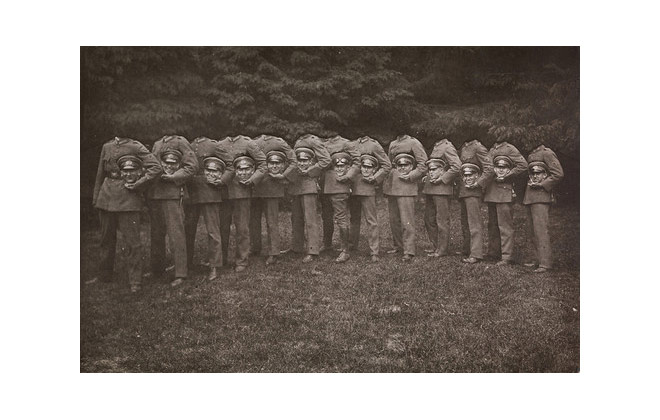science

A study published in 2003 supported this idea: participants who listened to music with the intention of feeling happier actually ended up feeling less happy than others who merely listened to the music with no happiness goal. […] But now a new study has come along which purports to show that trying deliberately to be happier is beneficial after all.
{ BPS | Continue reading }
psychology | January 29th, 2013 7:55 am

Regarding exorcism, the Catholic Encyclopedia says:
Exorcism is (1) the act of driving out, or warding off, demons, or evil spirits, from persons, places, or things, which are believed to be possessed or infested by them, or are liable to become victims or instruments of their malice; (2) the means employed for this purpose, especially the solemn and authoritative adjuration of the demon, in the name of God, or any of the higher power in which he is subject.
[…]
In contrast, the rationalist perspective presents historical and medically-based views of possession phenomena in terms of epilepsy, schizophrenia, and possession trance disorder (PTD), a possible variant of dissociative identity disorder. Nothing evil or supernatural takes over the identity of the person with PTD. Nonetheless, exorcisms performed on mentally ill people continue to this day. […]
In DSM-IV, spirit possession falls under the category of Dissociative Disorder Not Otherwise Specified, with more specific research criteria (but not an official diagnosis) fitting Dissociative Trance Disorder (possession trance):
Dissociative trance disorder: single or episodic disturbances in the state of consciousness, identity, or memory that are indigenous to particular locations and cultures. Dissociative trance involves narrowing of awareness of immediate surroundings or stereotyped behaviors or movements that are experienced as being beyond one’s control. Possession trance involves replacement of the customary sense of personal identity by a new identity, attributed to the influence of a spirit, power, deity, or other person and associated with stereotyped involuntary movements or amnesia, and is perhaps the most common dissociative disorder in Asia. Examples include amok (Indonesia), bebainan (Indonesia), latah (Malaysia), pibloktoq (Arctic), ataque de nervios (Latin America), and possession (India). The dissociative or trance disorder is not a normal part of a broadly accepted collective cultural or religious practice.
[…]
Will there be changes for Dissociative Trance Disorder (DTD) in DSM-5?
{ Neurocritic | Continue reading }
Linguistics, psychology | January 28th, 2013 2:33 pm

Men who were born without a sense of smell report having far fewer sexual partners than other men do, and women with the same disorder report being more insecure in their partnerships, according to new research.
The researchers don’t know why romantic difficulties could be tied to smell, but they say one possibility is that people with anosmia, or no sense of smell, are insecure, having missed many emotional signals all their life.
{ LiveScience | Continue reading }
photos { Sarah Pickering, Fuel Air Explosion (L), Land Mine (R) }
olfaction, sex-oriented | January 28th, 2013 8:04 am

Dishonest behavior seems pervasive. For example, the estimated total damage to the American clothing industry from wardrobing—the habit of returning purchased clothes after wearing, amounts to $16 billion annually, and the damage to US companies from employee theft and fraud reaches an estimate of $994 billion a year. On an individual level, research on lying has found that people lie in some 30% of their daily interactions. In stark contrast to these findings, most people, including those who engage in the above practices, maintain a positive moral self-concept. If being moral is so highly valued in society, why then is unethical behavior so pervasive? And what determines its extent?
In this paper, we propose that the individual’s perspective is an important factor that affects moral behavior and determines its extent. We use the term perspective to indicate the size of the window through which individuals perceive and evaluate their choices.
{ Judgment and Decision Making | Continue reading }
ideas, psychology | January 25th, 2013 2:57 pm

People who identify as strong multitaskers tend to be impulsive, sensation-seeking and overconfident in their ability to juggle multiple tasks simultaneously. In fact, note the researchers in the latest issue of PLOS, the people who multitask the most are often the least capable of doing so effectively.
[…]
“The people who are most likely to multitask harbor the illusion they are better than average at it,” says Strayer, “when in fact they are no better than average and often worse.”
{ io9 | Continue reading }
buffoons, psychology | January 25th, 2013 10:24 am

Research has shown that a number of factors, including body symmetry, perceived strength, vigour, skilfulness, and agility of movements, as well as increased variability and amplitude of the neck and trunk, can affect the attractiveness of dance moves. Perceived femininity/masculinity of body movement likely also plays a role.
Here, we compare comprehensive ratings of both male and female dancers’ opposite- sex attractiveness, including ratings of femininity/masculinity, with computationally-extracted movement features. Sixty-two heterosexual adult participants watched 48 short audio-visual point-light animations of eight male and eight female adults dancing individually to Techno, Pop, and Latin music. Participants rated perceived Femininity/Masculinity (as appropriate), Sensuality, Sexiness, Mood, and Interestingness of each dancer. Seven kinematic and kinetic features – Downforce, Hip wiggle, Shoulder vs. hip angle, Hip-knee phase, Shoulder-hip ratio, Hip-body ratio, and Body symmetry – were computationally extract- ed from the stimuli.
A series of correlations revealed that, for men watching women, Hip-knee phase angle was positively related to Interestingness and Mood, and that Hip-body ratio was positively related to Sensuality. For women watching men, Downforce was positively related to Sensuality. Our results highlight some interesting similarities and differences between male and female perceptions of attractiveness of opposite sex dancers.
{ University of Jyväskylä | PDF }
images { 1. Nathaniel Welch | 2 }
dance, psychology | January 25th, 2013 9:58 am

Explicit communication involves the deliberate, conscious choosing of words and signals to convey a specific message to a recipient or target audience. […] Much of human communication is also implicit, and occurs subconsciously without overt individual attention. Examples include nonverbal communication and subconscious facial expressions, which have been argued to contribute significantly to human communication and understanding. […] Additionally, recent studies conducted by evolutionary psychologists and biologists have revealed that other animals, including humans, may also communicate information implicitly via the production and detection of chemical olfactory cues. Of specific interest to evolutionary psychologists has been the investigation of human chemical cues indicating female reproductive status. These subliminally perceived chemical cues (odors) are often referred to as pheromones.
For two decades, psychologists studying ovulation have successfully employed a series of “T-shirt studies” supporting the hypothesis that men can detect when a woman is most fertile based on olfactory detection of ovulatory cues. However, it is not known whether the ability to detect female fertility is primarily a function of biological sex, sexual orientation, or a combination of both.
Using methodologies from previous T-shirt studies, we asked women not using hormonal contraceptives to wear a T-shirt for three consecutive nights during their follicular (ovulatory) and luteal (non-ovulatory) phases. Male and female participants of differing sexual orientations then rated the T-shirts based on intensity, pleasantness, and sexiness.
Heterosexual males were the only group to rate the follicular T-shirts as more pleasant and sexy than the luteal T-shirts. Near-significant trends also indicated that heterosexual men and non-heterosexual women consistently ranked the T-shirts, regardless of menstrual stage, to be more intense, pleasant, and sexy than did non-heterosexual men and heterosexual women.
{ Journal of Social, Evolutionary, and Cultural Psychology | PDF }
hormones, olfaction, relationships, sex-oriented | January 25th, 2013 8:44 am

“If a wife left her husband with three kids and no job/ to run off to fuck in Hawaii with some doctor named Bob/ you could skin them and drain them of blood so they die…especially Bob. Then you would be justice guy.” –Stephen Lynch, Superhero
[…]
The interesting thing about this particular song is the emphasis that Stephen puts on his urge to kill Bob. It’s interesting in that it doesn’t make much sense, morally speaking: it’s not as if Bob, a third party who was not involved in any kind of relationship with Stephen, had any formal obligation to respect the boundaries of Stephen’s relationship with his wife. Looking out for the relationship, it seems, ought to have been his wife’s job. She was the person who had the social obligation to Stephen that was violated, so it seems the one who Stephen ought to be mad at (or, at least madder at) would be his wife. So why does Stephen wish to especially punish Bob?
[…]
Too much punishing of his wife – in this case, murder, though it need not be that extreme – can be counterproductive to his goals, as it would render her less able to deliver the benefits she previously provided to the relationship.
[…]
Punishing third parties versus punishing one’s partner can be thought of, by way of analogy, to treating the symptoms or the cause of a disease, respectively. Treating the symptoms (deterring other interested men), in this case, might be cheaper than treating the underlying cause on an individual basis, but you may also need to continuously treat the symptoms (if his wife is rather interested with the idea of having affairs more generally).
[…]
A paper by Glaeser and Sacerdote (2003) examined whether victim characteristics (like age and gender) were predictive of sentencing lengths for various crimes. […] When the victim was a man, if the killer was also a man, he would get about 18 years, on average; if the killer was a woman, that number drops to 11.3. For comparison’s sake, when the victim was a woman and the killer a woman, she would get about 17.5 years; if the killer was a man, that average was 23.1 years.
{ Pop Psychology | Continue reading }
photo { Peter Turnley, Métro Franklin Roosevelt, Paris, 2000 }
ideas, psychology, relationships | January 25th, 2013 8:35 am

Jealousy is commonly known as a negative emotional reaction experienced when a relationship that is important to an individual is threatened by a rival. Perhaps then it is not surprising that jealousy can be viewed as a negative emotion that will only harm relationships. It is viewed as harmful to relationships due to its ability to evoke negative emotions such as anger, fear, and sadness. In addition, the onset of jealousy can occur for many different reasons that are associated with loss of affection, rejection, suspiciousness, insecurity, and anxiety. But, while jealousy can harm relationships, it can also help relationships.
Daly, Wilson, and Weghorst report that human males evolved defenses such as jealousy to protect them against wasting their efforts on children they had not sired. For a woman, jealousy provided a way to ensure that her male partner is investing resources in raising her offspring rather than squandering his resources on other women. Jealousy also evolved to protect love from the threat of loss and the threat of loss to a rival. So, while jealousy can lead to negative emotions, when it is properly used, it can also enhance relationships and provide mating benefits and enhance survival, i.e., it is an adaptive emotion.
{ Journal of Social, Evolutionary, and Cultural Psychology | PDF }
psychology, relationships | January 23rd, 2013 8:09 am

Problem #1: Inability to Focus
“The average office worker changes windows [on her computer] 37 times an hour,” Headspace’s head of research Nick Begley says in a meditation tutorial. According to Begley, when your mind changes gears that rapidly, part of your brain is still engaged in the previous task and you don’t have all of the attention and resources necessary to concentrate on the current task. […]
Problem #2: Stress
When people get stressed, there is a part of the brain called the amygdala that fires up the “fight or flight” part of the nervous system that helps you make quick, impulsive decisions. “It signals to our hormonal system to secrete adrenaline and cortisol and increases our heart rate, respiration, and blood pressure, so we can escape this immediate physical danger,” says Begley. The problem arises when there is no immediate physical danger–when, say, you’ve forgotten to hit “save” on an important document and your computer crashes, or you arrive unprepared for an important business meeting. […]
The Solution
Refreshing your brain is easier than you think. Here’s the first and only step: Do nothing. […] 10 minutes each day to quiet your mind. Practice observing thoughts and anxieties without passing judgment–simply experience them.
{ Inc. | Continue reading }
photo { Philip Lorca Dicorcia }
guide, hormones, psychology | January 23rd, 2013 8:00 am

Stairway climbing provides a ubiquitous and inconspicuous method of burning calories. While typically two strategies are employed for climbing stairs, climbing one stair step per stride or two steps per stride, research to date has not clarified if there are any differences in energy expenditure between them. Fourteen participants took part in two stair climbing trials. […] Two step climbing invokes a higher rate of energy expenditure; however, one step climbing is energetically more expensive in total over the entirety of a stairway. Therefore to expend the maximum number of calories when climbing a set of stairs the single-step strategy is better.
{ PLOS ONE | Continue reading }
health, science, sport | January 23rd, 2013 7:59 am

Scientists have identified genetic circumstances under which common mutations on two genes interact in the presence of cocaine to produce a nearly eight-fold increased risk of death as a result of abusing the drug.
The variants are found in two genes that affect how dopamine modulates brain activity. Dopamine is a chemical messenger vital to the regular function of the central nervous system, and cocaine is known to block transporters in the brain from absorbing dopamine after its release.
The same dopamine genes are also targeted by medications for a number of psychiatric disorders. The researchers say that these findings could help determine how patients will respond to certain drugs based on whether they, too, have mutations that interact in ways that affect dopamine flow and signaling.
{ The Ohio State University | Continue reading }
drugs, genes | January 23rd, 2013 7:55 am

Darwinian literary analysis is a way to examine texts and arrive at conclusions about evolved human behaviors, motivations, and emotions. That is, by analyzing texts, it is possible to indirectly analyze human nature. Recently, scholars have examined the works of Jane Austen, Harlequin romance novels, and folktales for this purpose. Although this prior work has been informative, it has only included heterosexual relationships.
Symons noted that lesbian and gay populations are a vital group to gain insight into evolutionary sex differences, as their relationships involve only same sex individuals, thus highlighting dominant female and male mating behaviors. Therefore, in this paper, our primary goal is to analyze lesbian pulp fiction to better comprehend women’s evolved mating strategies. We also consider the era that these books were most popular and explore the cultural climate in relation to the characters in the novels. In general, the way the characters are described and their relationship dynamics are consistent gender stereotypes concerning masculine versus feminine women.
{ Journal of Social, Evolutionary, and Cultural Psychology | PDF }
books, relationships, science | January 22nd, 2013 7:27 am

Research comparing regions in China with varied sex ratios has demonstrated that when available female partners are relatively more abundant, men are less likely to engage commercial sex workers, although they are likely to engage in more and more frequent sexual encounters outside of marriage; avoiding partnering that includes an explicit financial cost constitutes greater selectivity.
Other research indicates that when available female partners are relatively scarce, men are more likely to marry young, presumably motivated to secure an available partner against relatively less certain future mating opportunities; men are less likely to avoid partners who insist on marriage, indicating relatively lower selectivity. This also results in women marrying younger in populations characterized by sex ratios that skew male.
Although such studies document important and clear patterns, experimental exploration may provide added insight. Recent research, for example, examined women’s preferences for facial symmetry in men after viewing images of crowds in which sex ratios varied, revealing that women became more selective in their preferences when they perceived an abundance of men.
The present study seeks to extend experimental exploration of the impact of sex ratios in two ways: first, it examines the impact on men, and second, it examines the effects of sex ratios in media narratives rather than either real populations or still images.
{ Evolutionary Psychology | PDF }
psychology, relationships | January 22nd, 2013 7:27 am

Berkeley Earth has just released analysis of land-surface temperature records going back 250 years, about 100 years further than previous studies. The analysis shows that the rise in average world land temperature globe is approximately 1.5 degrees C in the past 250 years, and about 0.9 degrees in the past 50 years. […]
Many of the changes in land-surface temperature can be explained by a combination of volcanoes and a proxy for human greenhouse gas emissions. Solar variation does not seem to impact the temperature trend.
{ Berkeley Earth | Continue reading }
climate | January 21st, 2013 9:29 am

Scientists have struggled to understand the correlation between cold weather and the flu. […] The researchers found the virus survived best at humidity below 50%, similar to the conditions found indoors in “a really heated building,” says Dr. Marr. […] “It’s also fine in humidities above 98%, which you find in the rainy season in the tropics,” she says, where the conditions outside resemble the environment the virus finds in the body. “But in between, in a humidity of 50% to 98%, the virus doesn’t survive very well.”
The presence of influenza is quite rare in the spring, summer and fall, when people don’t use indoor heating as much and the humidity tends to be in the comfortable 50%-to-70% range. […]
A humidifier might be the best product to keep the flu at bay, Dr. Marr says. “If you can humidify to about 50%, but not above 60% [which can cause mold], you might reduce your chances of getting the flu,” she says.
{ WSJ | Continue reading }
guide, health, science | January 21st, 2013 9:12 am

Jessica, a 42-year-old forensic scientist, is typical of the lucky group. As she explained: “I have my dream job, two wonderful children and a great guy whom I love very much. It’s amazing; when I look back at my life, I realise I have been lucky in just about every area.”
In contrast, Carolyn, a 34-year-old care assistant, is typical of the unlucky group. She is accident-prone. In one week, she twisted her ankle in a pothole, injured her back in another fall and reversed her car into a tree during a driving lesson. She was also unlucky in love and felt she was always in the wrong place at the wrong time.
Over the years, I interviewed these volunteers, asked them to complete diaries, questionnaires and intelligence tests, and invited them to participate in experiments. The findings have revealed that although unlucky people have almost no insight into the real causes of their good and bad luck, their thoughts and behaviour are responsible for much of their fortune. […]
Personality tests revealed that unlucky people are generally much more tense than lucky people, and research has shown that anxiety disrupts people’s ability to notice the unexpected. […]
In the wake of these studies, I think there are three easy techniques that can help to maximise good fortune:
• Unlucky people often fail to follow their intuition when making a choice, whereas lucky people tend to respect hunches. Lucky people are interested in how they both think and feel about the various options, rather than simply looking at the rational side of the situation. I think this helps them because gut feelings act as an alarm bell - a reason to consider a decision carefully.
• Unlucky people tend to be creatures of routine. They tend to take the same route to and from work and talk to the same types of people at parties. In contrast, many lucky people try to introduce variety into their lives. For example, one person described how he thought of a colour before arriving at a party and then introduced himself to people wearing that colour. This kind of behaviour boosts the likelihood of chance opportunities by introducing variety.
• Lucky people tend to see the positive side of their ill fortune. They imagine how things could have been worse. In one interview, a lucky volunteer arrived with his leg in a plaster cast and described how he had fallen down a flight of stairs. I asked him whether he still felt lucky and he cheerfully explained that he felt luckier than before. As he pointed out, he could have broken his neck.
{ Richard Wiseman/Telegraph | Continue reading }
psychology | January 20th, 2013 3:11 pm

George Church, 58, is a pioneer in synthetic biology, a field whose aim is to create synthetic DNA and organisms in the laboratory. During the 1980s, the Harvard University professor of genetics helped initiate the Human Genome Project that created a map of the human genome.
SPIEGEL: Mr. Church, you predict that it will soon be possible to clone Neanderthals. What do you mean by “soon”? Will you witness the birth of a Neanderthal baby in your lifetime?
Church: That depends on a hell of a lot of things, but I think so. The reason I would consider it a possibility is that a bunch of technologies are developing faster than ever before. In particular, reading and writing DNA is now about a million times faster than seven or eight years ago. Another technology that the de-extinction of a Neanderthal would require is human cloning. We can clone all kinds of mammals, so it’s very likely that we could clone a human. […]
SPIEGEL: So let’s talk about possible benefits of a Neanderthal in this world.
Church: Well, Neanderthals might think differently than we do. We know that they had a larger cranial size. They could even be more intelligent than us. When the time comes to deal with an epidemic or getting off the planet or whatever, it’s conceivable that their way of thinking could be beneficial.
SPIEGEL: How do we have to imagine this: You raise Neanderthals in a lab, ask them to solve problems and thereby study how they think?
Church: No, you would certainly have to create a cohort, so they would have some sense of identity. They could maybe even create a new neo-Neanderthal culture and become a political force.
{ Der Spiegel | Continue reading }
genes, science | January 20th, 2013 7:18 am

Artists, creative writers, and musicians have long been interested in the complex motives that spark passionate love, sexual desire, and sexual behavior. Recently, scholars from a variety of disciplines have begun to investigate two questions: “Why do men and women choose to engage in sexual liaisons?” “Why do they avoid such encounters?” Theories abound. Many theorists have complained that there exists a paucity of scales designed to measure the plethora of motives that prompt people to seek out or to avoid sexual activities. In fact, this observation is incorrect. Many such scales of documented reliability and validity do exist. The reason that few scholars are familiar with these scales is that they were developed by psychometricians from a variety of disciplines and are scattered about in an assortment of journals, college libraries, and researchers’ desk drawers, thus making them difficult to identify and locate. This paper will attempt to provide a compendium of all known sexual motives scales, hoping that this will encourage scholars to take a multidisciplinary approach in developing typologies of sexual motives and/or in conducting their own research into the nature of sexual motives. […]
Until recently, American sexologists generally assumed that young people engage in sexual activities for one of three reasons (the Big Three): love, a desire for pleasure, and/or a desire to procreate. […] Take a foray into the worlds of culture, art, and literature, however, and suddenly one becomes aware of how narrow the perspective of the Western scientist has been. There are a multitude of reasons why men and women might wish to engage in sexual activities. As Levin (1994) observed: “Coitus is undertaken not only for pleasure and procreation but also to degrade, control and dominate, to punish and hurt, to overcome loneliness or boredom, to rebel against authority, to establish one’s sexuality, or one’s achieving sexual competence (adulthood), or to show that sexual access was possible (to “score”), for duty, for adventure, to obtain favours such as a better position or role in life, or even for livelihood.”
{ Interpersona | Continue reading }
photo { Man Ray, Prayer, 1930 }
psychology, sex-oriented | January 18th, 2013 3:39 pm

The question is, what happens to your ideas about computational architecture when you think of individual neurons not as dutiful slaves or as simple machines but as agents that have to be kept in line and that have to be properly rewarded and that can form coalitions and cabals and organizations and alliances? This vision of the brain as a sort of social arena of politically warring forces seems like sort of an amusing fantasy at first, but is now becoming something that I take more and more seriously, and it’s fed by a lot of different currents.
Evolutionary biologist David Haig has some lovely papers on intrapersonal conflicts where he’s talking about how even at the level of the genetics, even at the level of the conflict between the genes you get from your mother and the genes you get from your father, the so-called madumnal and padumnal genes, those are in opponent relations and if they get out of whack, serious imbalances can happen that show up as particular psychological anomalies.
We’re beginning to come to grips with the idea that your brain is not this well-organized hierarchical control system where everything is in order, a very dramatic vision of bureaucracy. In fact, it’s much more like anarchy with some elements of democracy. Sometimes you can achieve stability and mutual aid and a sort of calm united front, and then everything is hunky-dory, but then it’s always possible for things to get out of whack and for one alliance or another to gain control, and then you get obsessions and delusions and so forth.
You begin to think about the normal well-tempered mind, in effect, the well-organized mind, as an achievement, not as the base state, something that is only achieved when all is going well, but still, in the general realm of humanity, most of us are pretty well put together most of the time. This gives a very different vision of what the architecture is like, and I’m just trying to get my head around how to think about that.
{ Daniel C. Dennett/Edge | Continue reading }
photo { Robert Heinecken }
brain, neurosciences, photogs | January 18th, 2013 9:36 am






















